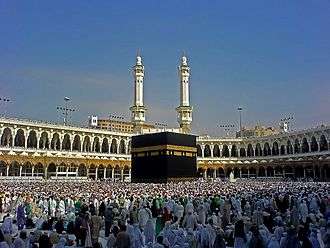Sitting in salah
Sitting or kneeling is an integral step in the cycle or unit of the Islamic salah called a raka'ah.
Types of sitting
There are three methods of sitting according to the sunnah, the example of Muhammad. One is sitting on the left foot along the ground with the right foot upright. Another is resting on both the heels.[1][2] A third way is sitting with the left thigh on the ground and both feet protruding from the right side with the right foot either upright or along the ground. In this method, the left palm leans on the left knee. This third method is implemented in the third or fourth raka'ah.[1][2]
Overview
There can be two occasions of sitting in a regular raka'ah. One is after the first prostration and the other is after the second prostration, sometimes referred to as the tashahhud.
The first two methods of kneeling is used alternatively by Muslims after the first prostration and the during the first tashahhud. In the second tashahhud, the third method of sitting is used and the index finger is pointed towards the qibla, which is the direction of Mecca.[1][2]
If this is the last raka’ah, the prayer is commenced in sitting position by reciting greetings of salam to the right such as السلام عليكم ورحمة الله (transliteration “As-Salaamu 'alaykum wa rahmatullaah,” meaning “May Allah grant you peace and security, and may His Mercy be upon you”) and then similarly to the left.[1][2]
Sayings during sitting
Muslims recite the "tashahhud," referring to the shahada or the declaration of faith in Islam. The sunni version is At-tahiyyatu lillahi was-salawatu wat-tayyibatu as-salamu 'alayka ayyuha Annabiyyu warahmatullahi wabarakatuhu Assalamu 'alayna wa 'ala `abadillahi assaliheena Ash-hadu anna la ilaha illa Allah Wa Ash-hadu anna Mohammmedan 'abduhu warasuluhu.
In the Shia version, according to Ayatullah Sistani,[3] is "Ash hadu an la ilaha illal lahu wahdahu la sharika lah, wa ash hadu anna Muhammadan 'Abduhu wa Rasuluh, Alla humma salli 'ala Muhammadin wa aleh Muhammad". And it will be sufficient if one recited the tashahhud this way: Ash hadu an la ilaha illal lahu was ash hadu anna Muhammadan Sallal lahu Alayhi Wa Aalihi Abduhu Wa rasuluh.
Muslims also recite greeting such as: اللَّهُمَّ صَلِّ عَلَى مُحَمَّدٍ وَعَلَى آلِ مُحَمَّدٍ، كَمَا صَلَّيْتَ عَلَى إِبْرَاهِيمَ وَعَلَى آلِ إِبْرَاهِيم، إِنَّكَ حَمِيدٌ مَجِيدٌ، اللَّهُمَّ بَارِكَ عَلَى مُحَمَّدٍ وَعَلَى آلِ مُحَمَّدٍ كَمَا بَارَكْتَ عَلَى إِبْرَاهِيمَ وَعَلَى آلِ إِبْرَاهِيمَ، إِنَّكَ حَمِيدٌ مَجِيدٌ (transliteration “Allaahumma salli 'alaa Muhammadin wa 'alaa aleh Muhammadin Kamaa sallaita 'alaa Ibraaheema wa 'alaa aleh Ibraaheema Innaka hameedun Majeed Alaahumma baarik 'ala Muhammadin wa 'alaa aleh Muhammadin Kamaa baarakta 'alaa Ibraaheema wa 'alaa aleh Ibraaheema Innaka hameedun Majeed,” meaning “O Allah, bless our Muhammad and the people of Muhammad as you have blessed Abraham and the people of Abraham. O Allah, be gracious unto Muhammad and the people of Muhammad As you were gracious unto Abraham and the people of Abraham. Surely you are the Most Praiseworthy, the Most Glorious.”)
The greetings in the Shia version, according to Ayatullah Sistani,[4] is "Assalamu 'alayka ayyuhan Nabiyyu wa rahmatullahi wa barakatuh. Assalamu Alaykum." Alternatively, "Assalamu Alayna Wa Ala Ibadi llahis Salihin. Assalamu Alaykum."
See also
References
- 1 2 3 4 Haddad, Yvonne Yazbeck; Smith, Jane I. (2014-01-01). The Oxford Handbook of American Islam. Oxford University Press. p. 162. ISBN 9780199862634.
- 1 2 3 4 Shaikh Muhammad Ilyas Faisal, "Sifatus Salat: The Method of Salat in Light of the Authentic Ahadith." Madinat al-Munawwara. 08, October, 2014.
- ↑ http://www.sistani.org/local.php?modules=nav&nid=2&bid=59&pid=2958
- ↑ http://www.sistani.org/local.php?modules=nav&nid=2&bid=59&pid=2959
External Links
- Detailed Account of Prayer by Abu Yusuf Riyadh ul Haq
- Placing the hands in Prayer by Sheikh Faraz Rabbani
